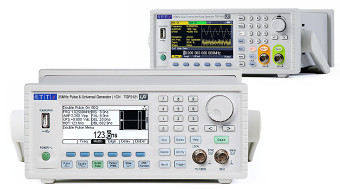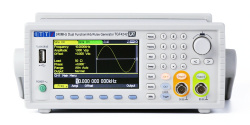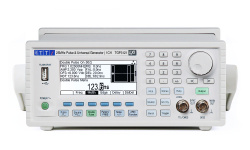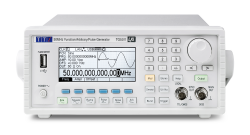Générateurs arbitraires

Générateurs de signaux arbitraires avec une, deux ou quatre voies
Générateurs de fonctions et de signaux arbitraires combinant deux types de synthèses, une horloge variable et une architecture DDS (Direct Digital Synthesis pour synthèse numérique directe).
Interface programmable via GPIB, RS-232 et LAN (LXI).
Génération de signaux et logiciel d’édition de formes d’ondes.
Générateurs de fonctions et de signaux arbitraires combinant deux types de synthèses, une horloge variable et une architecture DDS (Direct Digital Synthesis pour synthèse numérique directe).
Interface programmable via GPIB, RS-232 et LAN (LXI).
Génération de signaux et logiciel d’édition de formes d’ondes.
Select by Product Series
| Dual Channel Arbitrary Function Generator with 40 to 240MHz models | |
| Pulse and Universal Generator with 25 or 50MHz models, single or dual channel | |
| High Performance Function/Arbitrary/Pulse Generator 25MHz or 50MHz, 1 or 2 Channels |
Function Generator Types
Digital / DDS Function Generators
Digital generators use a digital to analogue converter (DAC) to generate a wave shape from values stored in memory. Basic generators only offer sine and square waves up to the maximum generator frequency. Triangle waves and other waveforms are limited to a much lower frequency.Direct Digital Synthesis (DDS) is a method of producing an analogue waveform; usually a sine wave; by generating a time-varying signal in digital form and then performing a digital-to-analogue conversion. DDS offers fast switching between output frequencies, fine frequency resolution, and operation over a broad spectrum of frequencies.
Arbitrary Generators
Arbitrary generator describes a class of digital generator potentially capable of reproducing any waveform shape. There are two distinctly different ways in which arbitrary waveforms can be produced: DDS and Variable Clock.Arbitrary Generators: Direct Digital Synthesis (DDS)
These generators use DDS for the production of both standard waveforms (function generator mode) and arbitrary waveforms. These are most commonly described as either Function/Arbitrary Generators or Arbitrary/Function Generators (AFG). The Aim-TTi TGF4000 series represents the latest and most accurate use of DDS technology and digital control architecture to release the ultimate DDS performance in a Function/Arb /Pulse generator.Arbitrary Generators: Variable Clock
These generators also use DDS for the production of standard waveforms (function generator mode), but use a variable clock for generating arbitrary waveforms. These may be described as Universal Arbitrary Waveform Generators or simply Arbitrary Waveform Generators (AWG) or Variable clock Arbitrary generators. Arbitrary Generators with a variable clock permit waveform linking, looping and sequencing. Arbitrary waveforms may be replayed at a specified waveform frequency, period or sample rate. An external sample clock can also be used as the clock generator. True Arb architecture avoids the clock jitter associated with DDS arbitrary generators.Analogue Function Generators
Analogue generators use a voltage controlled oscillator to generate a triangular waveform of variable frequency. Sinusoids and square waves are generated from this. DDS has largely replaced Analogue in modern Function Generators. The use of analogue technology is now limited to low cost basic generators and to high performance very low distortion signal sources. The advantages of analogue generators are restricted to the purity of the waveform. The Aim-TTi TG300 series are good examples of a low-cost analogue Function Generators.Pulse Generators
Unlike DDS based function generators, pulse generators operate with very low jitter and high resolution of pulse width and delay. They can also operate in an asynchronously triggered mode with low jitter. This differs markedly from the pulse function of most DDS function generators where width and delay are defined by the system clock period and are one to two orders of magnitude less precise.The Aim-TTi TGP3100 Series are true pulse generators using all digital techniques. They can replicate the capabilities of traditional analogue pulse generators whilst adding many additional facilities such as pulse modulations.



